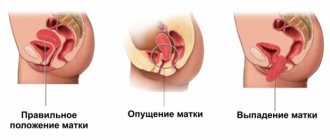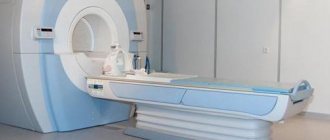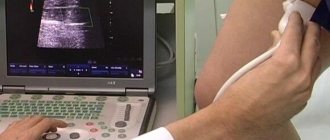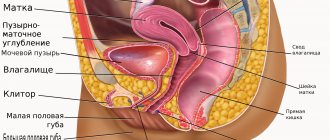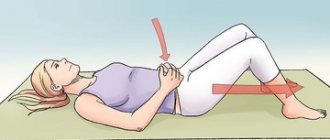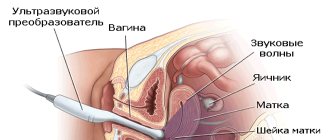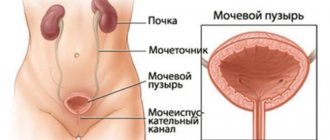Uterine prolapse is caused by incompetent pelvic floor muscles. Due to weakening or pathological changes, their ability to support the organs of the pelvic region in their natural position is impaired, which, in the absence of adequate therapy, leads to complete prolapse of the uterus.
The diagnosis is quite common. But since it does not have characteristic symptoms at the formation stage, women get to the specialist’s office late.
Symptoms of uterine prolapse
Symptoms of uterine prolapse - at the beginning of the formation of the condition - are non-specific. Potential signs include:
- The appearance of minor pain in the suprapubic region when staying in one position for a long time. After changing the position, it begins to subside.
- There is a feeling of the presence of some object in the vagina. This is an edematous uterus that puts pressure on the walls of the vaginal tube.
- Disturbances in urination and bowel movements develop.
- The walls of the vaginal tube subsidence and eversion occurs.
Important! Signs of uterine prolapse vary. For example, patients may experience pain in the lower abdomen when walking or complain about the disappearance of sexual desire.
As the condition worsens, the following symptoms develop:
- nagging pain in the suprapubic area, lumbar and sacral spine,
- feeling of a foreign object in the vagina,
- specific sensations during sex,
- pain and bloody discharge,
- menstruation disorders,
- frequent urge to go to the toilet, urinary incontinence,
- urological problems - inflammation of the bladder walls, pyelonephritis,
- colitis, rare dry stools, etc.
With advanced disease, the patient is able to detect uterine prolapse on her own. The protruding mucosa is regularly injured when walking, which contributes to the formation of bleeding, infected abrasions on its surface.
The condition is accompanied by impaired local circulation, which provokes the development of stagnation of venous blood, swelling and cyanosis of the mucous membrane.
Important! With significant displacement, sexual activity stops completely.
Therapeutic exercises for prolapse of the vaginal walls
Therapeutic exercises for prolapse of the vaginal walls are effective provided that the woman regularly performs the exercises described below. The set of exercises is selected taking into account:
- anatomical features of the structure of the small pelvis;
- individual characteristics of the patient;
- the current stage of prolapse development.
Before prolapse of the anterior vagina occurs, exercise to strengthen the pelvic floor muscles can reduce the likelihood of prolapse of the organs of the reproductive system. The training is recommended for women prone to prolapse of the uterus and vaginal walls.
Classes to eliminate prolapse boil down to regularly performing the following gymnastic exercises in a supine position:
- Feet together, arms along the body. While exhaling, the lower limbs should be slowly raised up. As you inhale, they separate. On the next exhalation, the legs are brought together again. Such gymnastics for prolapse of the vagina is repeated at least 7 times in one approach.
- Hands are placed behind the head, legs are brought together. Raise your pelvis to the maximum possible point. At the same time, tighten the muscles near the anus. These steps should be repeated 10 times.
- Trying not to bend your legs, you need to bring them behind your head and touch your toes to the floor. Movements are performed at a slow pace. The exercise is repeated 6 times.
- The legs are brought together and slowly raised above the floor until they form an angle of 45 degrees. Repeat 8 times.
- Bend your knees so that your feet touch the floor and spread to the sides. The hands are placed behind the head. When lifting the pelvis, your legs should be spread as wide as possible and the muscles near the anus should be tense. The exercise is repeated 10 times.
- Straight legs rise above the floor in turn.
Charging for vaginal prolapse comes down to doing the “bicycle” exercise every day. In addition to the above classes, the following workouts are prescribed (performed while standing on all fours):
- While inhaling, you need to simultaneously raise your right (left) arm and left (right) leg. At the exit, the limbs are lowered. The exercise is repeated at least 6 times.
- While inhaling, you should tighten your pelvic muscles and raise your head. On exit, return to the starting position. The exercise is repeated 10 times.
- Emphasis on the elbows. The right and left legs are lifted in turn. The exercise is repeated 10 times.
Exercises are performed 2 hours before or 2 hours after meals. The duration of classes is not limited. It is recommended to do the exercises every day.
https://youtu.be/PcIGORMBQp4
Causes of uterine prolapse
Doctors call the leading factors:
- injury to the muscle layer lining the pelvic floor,
- violation of the integrity of the walls of the uterus, cervical canal, perineum during the period of delivery,
- congenital defects of the structure of the uterus.
Provoking factors may be:
- age indicator,
- too much physical activity,
- frequent delivery,
- increased level of intra-abdominal pressure.
What Kegel exercises will help with prolapse of the vaginal walls?
It is necessary to perform exercises in sets, squeezing the pelvic floor muscles:
Exercise 1
- Squeeze and unclench the pelvic muscles 3 times for 10 seconds, break no more than 10 seconds.
- Squeeze the muscles 9 times for 5 seconds, break between approaches no more than 5 seconds.
- Squeeze the muscles 2 times for 30 seconds and break for 30 seconds.
Then repeat the very first exercise.
Exercise 2
- Squeeze muscles 10 times for 5 seconds
- Squeeze and relax muscles 10 times – 3 sets
- Tighten your muscles for about 120 seconds, then do the whole exercise all over again.
Exercise 3
- Squeeze the muscles 40 times. After a few days, increase to 50, etc. The number of muscle contractions must be increased to 100.
- Tighten your muscles as hard as possible and hold in this position for 20 seconds, then break for 30 seconds and 5 more approaches.
Exercise 4
Simply tense your muscles for at least two minutes, then increase the time to 20 minutes. This must be done at least 3 times a day.
How the uterus falls out
There are several scenarios for the development of the disease:
- partial movement of the cervix into the lumen of the vaginal tube,
- prolapse – complete exit of an organ beyond the genital opening,
- cystotele – displacement of the uterus with simultaneous prolapse of the bladder,
- Rectocele is a combined prolapse of the rectum and uterus.
Another delicate problem
Another unpleasant problem that people are ashamed to talk about out loud is prolapse of the pelvic organs. “After a certain age, almost half of women suffer from this disease,” states Denis Chinenov. — Often prolapse of the genital organs is associated with pregnancy and childbirth (the nervous regulation of tissues is injured and the tone of the pelvic muscles decreases); weakness of the pelvic muscles (urinary incontinence in nulliparous women shows that the causes are hidden by other factors, not just trauma to the pelvic muscles during childbirth); genetic weakness of connective tissue; the presence of factors that contribute to an increase in intra-abdominal pressure (excess weight, chronic cough, constipation). Moreover, women become aware of the disease only when they begin to experience discomfort in the lower abdomen, an unpleasant feeling of pressure, heaviness, problems with emptying the bladder and pain in the lower back, which intensifies towards the end of the day.” Then the unpleasant symptoms grow like a snowball: there is a disturbing feeling of “protrusion” inside the vagina, bladder infections occur, constipation torments and sexual life is disrupted due to pain during sexual intercourse. In addition, the disease changes the internal structure of the pelvis. Often, prolapse of the anterior vaginal wall occurs along with the bladder and urethra, and can involve the rectum and small intestine.
Known causes of the disease
Doctors call the most well-known causes of pathology:
- injury to the muscle layer during childbirth,
- gynecological operations,
- natural weakening of the muscle corset due to age-related changes,
- work involving regular heavy lifting,
- chronic constipation,
- predisposition at the genetic level,
- gynecological pathologies - cyst, fibroid, fibroid - putting a significant load on the system of ligaments that support the uterus.
What are the degrees of the process?
There are several degrees:
- First. The neck of the organ descends to the vestibule of the vagina. When the perineum is tense, it does not fall out.
- Second. Partial loss is noted. When muscle tension occurs, the cervix gapes out of the genital slit.
- Third. The cervix and part of the body of the uterus come out.
- Fourth. Complete loss. The body of the uterus is completely below the vestibule of the vagina.
Why do exercises for prolapsed vaginal walls?
Exercises for vaginal prolapse can achieve several results:
- speed up the body's recovery after childbirth;
- improve the quality of intimate contacts;
- stop or reduce the intensity of symptoms characteristic of the initial stages of prolapse;
- cope with uncontrolled release of urine, feces, and intestinal gases.
Helps to understand the features that distinguish therapeutic exercises for vaginal prolapse, video. You can also use a mirror to identify the desired muscle group. It should be placed opposite the perineum. After this, you should squeeze and relax the muscles several times.
Gymnastic exercises
The pelvic floor is covered with a layer of muscle that holds the organs in their natural position. Specific exercises will help strengthen the muscle corset.
Kegel exercises for uterine prolapse
Kegel gymnastics is recognized as the most effective complex that strengthens intimate female muscles.
- You need to tense your perineum and record the sensation for 3–11 seconds. Relax. Repeat the movement 9 – 13 times. Gradually increase the period of tension to 1.5 minutes.
- It is necessary to alternately contract and relax the muscles of the perineum, fixing the tension for 4 - 6 seconds. Do 3 – 5 repetitions.
- You need to alternately strain the perineum and anal area, holding in each position for 5 to 20 seconds. The minimum number of repetitions is 10 times.
- It is necessary to imitate labor attempts, fixing the tension for 5 – 10 minutes. The minimum number of repetitions is 5 times.
Do not hold your breath during all exercises. It must remain free.
Gymnastics according to Yunusov
If Kegel gymnastics leads to strengthening only the intimate muscles, then exercises according to Yunusov help to work out the abdominal press, urethral sphincter, and rectal muscles.
Which is better for thrush - Flucostat or Diflucan How to delay menstruation - using oral contraceptives The first signs of uterine cancer at an early stage Length (size) of the cervix during pregnancy by week
The complex is represented by the following exercises:
- "Mill". IP - standing, torso parallel to the floor, arms apart at shoulder level. Bend, touching your left palm to your right foot and vice versa. The minimum number of repetitions of movements is 10 times.
- Pelvic rotations. IP – standing, palms on the waist. Perform circular movements with your lower body, first in one direction, then in the opposite direction. The number of repetitions is 12 times in both directions.
- Squats. IP – feet shoulder-width apart. During a squat, you need to quickly return to the starting position from the lowest point. Number of repetitions – 11 times.
- IP - sitting on the floor, legs bent at the knees. We spread the limbs apart, then bring them together, synchronously straining/relaxing the perineum. Number of repetitions – 6 times.
- Turns. IP - standing straight, palms on the waist. Make turns 12 times in each direction. The lower part of the body is always fixed - only the torso takes part in the movement.
- Rifles. IP - lying down, legs bent at the knees, pulled up to the chest, fixed with hands. Make rolls. Number of repetitions – 5 times.
- "Bike". Rotate the pedals for at least 60 seconds.
Features of performing exercises for the pelvic floor muscles
Regular practice is important, because only then can you get the desired result. But it is extremely important not to overtrain: too high an intensity of exercise can negatively affect the functioning of the intimate muscles.
Strengthening the vaginal muscles
The complex of this direction includes three main exercises.
- It is necessary to tense your intimate muscles. Record the sensation for a few seconds (as long as you can) and release it.
- It is necessary to tense the intimate muscles, gradually increasing the compression power.
- Alternately tense and “release” the perineum in a comfortable mode.
Additional exercises to strengthen the abdominal and paravertebral muscles
At the beginning of classes, the number of repetitions is 4...6 times. Then their number must be increased to 14...21 times.
- "Bike". IP – we lie on the floor on our backs, bend our legs at the knees, and lift them above the floor. We imitate riding a bicycle, i.e. spinning imaginary pedals in the air.
- "Scissors". IP – lie face up, legs slightly raised above the floor. We cross the limbs.
- IP – lie on your back, legs straightened. Slightly lift your limbs up and hold for 1 to 4 seconds. As the muscles strengthen, the period of holding the legs should be increased to 15 seconds.
- IP - lying face up. Bend your knees, feet on the floor. Raise the pelvis while simultaneously tensioning the perineal area.
- IP – lie on your stomach, hands on the floor above your head. We simultaneously raise our limbs.
Advice! Walking up the stairs shows good results.
The complex must be performed daily. It is allowed to be practiced as a preventative exercise, minimizing the likelihood of uterine prolapse and the formation of other female problems.
Additional exercises to strengthen the abdominal and paravertebral muscles
Kegel gymnastics for prolapse of the uterus is complemented by complexes, the implementation of which helps to increase the power of the muscular corset of the torso. To do this, it is recommended to perform the exercises “bicycle”, “birch tree”, “boat”, “swallow”, “kitty” (with forced tension of the perineal muscles) every day.
Also useful are holding elevated straight legs while lying on your back, walking in a semi-squat, squeezing a gymnastic ball with your knees and hips, and climbing stairs.
The regimen of such gymnastics depends on general physical fitness. At first, it can be performed several times a week. Subsequently, exercise becomes daily, and the number and duration of approaches increases.
Strengthening muscles is possible only by regularly performing gymnastics with sufficient load and alternating tonic and dynamic contractions. This approach is also advisable for preventing uterine prolapse if a woman is at risk for developing this disease.
But we should not forget that Kegel gymnastics to strengthen the pelvic floor cannot always correct the position of the pelvic organs and eliminate their prolapse. Therefore, even with stage 1 uterine prolapse, the doctor may recommend additional treatment to reduce the rate of progression of the process and prevent complications.
You will find a more detailed description of Kegel exercises, various additional complexes and about Atarbekov’s gymnastics for uterine prolapse in our separate article.
Treatment of uterine prolapse with folk remedies
Traditional methods can be used to treat the disease.
- Combine 2 cups of vegetable oil and 250 grams of beeswax. Heat the mixture in a water bath to obtain a homogeneous mixture. Add boiled egg yolk to it. Stir. Lubricate tampons with the resulting composition before inserting into the vagina. Leave it on all night.
- Birch tar is used to warm the genital area. Place heated cobblestones, tar and chopped garlic in a tall enamel basin. Cover its edges with a thick cloth and sit on top. The duration of the session is no more than 13 minutes.
- Every day you need to drink an alcohol tincture of astragalus roots or lemon balm leaves. Take the drug before meals three times a day.
- Baths with dandelion infusion. To prepare the composition, pour 20 grams of crushed leaves of the plant with boiling water (2 l). Leave the product for 2-3 hours. Filter and add to a warm bath. Duration of bathing is 15 minutes.
Kegel exercises: benefits, rules of execution
The author of the gymnastics recommended for uterine prolapse is Arnold Kegel. Initially, he developed several useful exercises to help women with incontinence. However, gymnastics subsequently became popular due to its ability to strengthen intimate muscles.
Kegel exercises allow you to:
- strengthen the muscles of the vagina and anus, restore their tone;
- return the genitals to their normal position;
- improve blood circulation;
- normalize intra-abdominal pressure, improve intestinal function.
Kegel exercises help strengthen the pelvic floor muscles
Recommendations for performing exercises
To benefit from Kegel exercises, you need to follow some guidelines:
- classes should be held every day (and subsequently several times);
- you need to increase the load and duration of exercises gradually;
- it is necessary to control breathing: exhale after a short delay;
- you should try to leave your stomach in a relaxed state and your navel motionless;
- contractions should be carried out only with the help of the pelvic floor muscles without involving the muscles of the legs and buttocks.
You can practice lying down (on your back or stomach) or, if convenient, a sitting position is allowed.
How to recognize intimate muscles
At first, it will not be easy to determine the location of the required muscle group in the perineal area. Therefore, for beginner Kegel “athletes,” contractions involve almost all the muscles of the pelvic area. But over time (subject to conscientious daily training), you can learn to feel the body more subtly and work certain necessary muscles.
It is recommended to train the ability to feel the muscles of the urethra, vagina and anus during urination. Purposeful cessation of this action will allow you to feel how muscle contraction occurs in the pelvic area. Once you learn to control the right muscles, there will be no need to use this method; in addition, it can be harmful to your health.
Using special simulators
Some textbooks contain recommendations on the use of special vaginal simulators. This can be one or several balls of different diameters and shapes, or an elastic pear. However, additional objects should be used with caution because they can damage the low-lying cervix and atrophic vaginal walls. Before you start using such elements, you should talk to your doctor. It is also advisable to start using simulators after you learn how to properly contract the required muscles without them.
Vaginal trainers should be used with caution to avoid damaging the prolapsed cervix and vaginal walls.
Impact of the disease on current and future pregnancies
Prolapse of the uterus during pregnancy can negatively affect the process of bearing a child. If a woman, knowing about the diagnosis, has completed the necessary therapeutic course, then gestation will proceed without complications.
In general, the course of pregnancy is influenced not only by the degree of organ prolapse, but also by the weight of the woman and the fetus. The most severe complication is the development of premature labor. That is why women with such a pathology are recommended to go to bed a little more often “for preservation.”
Other exercises to lift the uterus
The “lift” and “bag” exercises are basic and mandatory exercises. If there are more serious problems, the complex can be supplemented with the manipulations listed below (but they must be selected and resolved by a doctor):
- "Pushing out." You need to lie with your back on the floor, bend your legs slightly and spread them. Place your hands on the lower abdomen. Perform tension on the abdominal muscles, reminiscent of pushing. The exercise is allowed in the early stages of the problem.
- "Blinking" It is done on the back. Alternately tense the muscles of the vagina and anus. Each squeeze should take 5 seconds. The same workout can be done while sitting or standing. You can do up to 500 repetitions throughout the day. This kind of method is especially useful after childbirth - it will help improve the health of the reproductive tract.
- "All the muscles." Lie with your back down, knees half bent. You need to actively strain the muscles of the perineum, urinary system, and anus. Hold this position for up to a minute. Depending on your condition, you can first reduce the fixation time. This exercise is very effective for prolapse of the anterior wall of the uterus.
- "SOS" Involves rhythmic contraction of muscles at a pace reminiscent of Morse code. We do the first three compressions intensely and quickly. This is followed by a series of three prolonged tensions. Then again three intense movements. In one session you need to repeat 10 times without a break.
- "Lighthouse". In a lying position, spread your bent knees wider than your shoulders. Set the rhythm, counting to 10: 1 - strongly squeeze the muscles of the vagina and perineum, 2-6 - slowly relax it, 7-9 - imitate pushing, 10 - take the original position. This exercise is contraindicated within a month after an abortion and within 1.5 months after childbirth. It is also unacceptable in case of severe violations.
- "Cat". Breathing plays an important role in this exercise. Take a breath. As you exhale, pull in your stomach and arch your back. Inwardly squeeze the muscles in the perineum area, hold for 10 seconds and relax. You can do up to five approaches.
- "Bridge". Lying position. As you exhale, lift your back. The ankles should be pressed to the buttocks. Raising your back, simultaneously pull in the muscles of the perineum, tighten your stomach and vagina. You can do five repetitions in one approach.
- "Applause". While lying down, move your feet toward your buttocks. Clap your hands and work your vaginal muscles at the same time. Perform alternating fast and slow vaginal compressions for three minutes.
- "Butterfly". You need to sit on a gymnastic mat, lean on your hands behind you. Bend your knees and bring your feet as close to your perineum as possible. Spread your legs. As you exhale, draw in the tense muscles of the perineum. Inhaling, gently push yourself back to the starting position.
Gymnastics will help you navigate during uterine prolapse in pictures.
